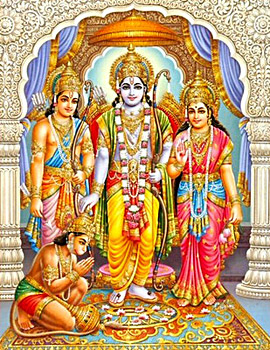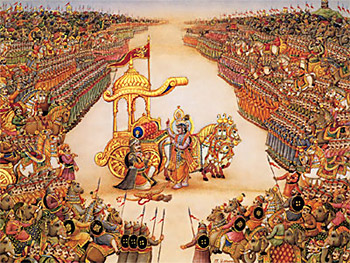 Vaishnavism in the epics of the Ramayana and the Mahabharata led to the further development of the essential tenets of Vaishnava Philosophy and Religion. The two Itihasas of the Ramayana and Mahabharata also includes the Bhagavad Gita. The Ramayana is the older epic since there are references to Lord Rama`s avatara in the Mahabharata. It is regarded by the Vaishnava acaryas as a Sarandgati-sastra, a text expounding the doctrine of self-surrender. The episode of Vibhisana who deserts his kingdom, family and all wealth and seeks the refuge of Sri Rama is a classic illustration of saraijagati. It is also regarded as a text expounding the greatness of Goddess Laxmi through the character of Sita. Valmiki himself states that Ramayana is essentially the portrayal of Sita`s character.
Vaishnavism in the epics of the Ramayana and the Mahabharata led to the further development of the essential tenets of Vaishnava Philosophy and Religion. The two Itihasas of the Ramayana and Mahabharata also includes the Bhagavad Gita. The Ramayana is the older epic since there are references to Lord Rama`s avatara in the Mahabharata. It is regarded by the Vaishnava acaryas as a Sarandgati-sastra, a text expounding the doctrine of self-surrender. The episode of Vibhisana who deserts his kingdom, family and all wealth and seeks the refuge of Sri Rama is a classic illustration of saraijagati. It is also regarded as a text expounding the greatness of Goddess Laxmi through the character of Sita. Valmiki himself states that Ramayana is essentially the portrayal of Sita`s character.
The Ramayana depicts that the way in which Lord Vishnu incarnated Himself in the form of a human being as the son of the emperor Dasaratha, extols the significance of avatara. Laksmana and Bharata are presented as the personification of the two important Vaishnava concepts, viz., dasatva or service to Bhagavan as the sole purpose of an individual soul and Bhagavad-bhakti or the worship of God with devotion. Satrughna symbolises the Bhagavata-kaihkarya or service to a God`s devotee which is considered to be of greater spiritual value than Bhagayat-kaihkarya or service to God. The Vaishnava acharyas including Ramanuja have freely drawn material from the Ramayana in developing the theological doctrines of Vaishnavism.
Following the Ramayana, the next important text in the development of Vaishnavism is the Mahabharata. It can almost be considered as encyclopaedia of the Vaishnava philosophy and religion. Though it deals with many other topics relating to social and ethical values and also other religions such as Shaivism, it lays greater emphasis on the various doctrines of Vaishnavism. It is regarded as the fifth Veda (pancama veda). The doctrines of Pancaratra are found recorded for the first time in the Narayaniya section of Santiparva of the Mahabharata. The identity of Vishnu, with Vasudeva, Narayana and Bhagavan as well as with Krishna is established in the Mahabharata. The devoted worship of Vishnu or Vasudeva as the sole means of moksha is brought out emphatically in this Itihasa. The Moksa-dharma section of Santiparva is devoted to the presentation of the philosophy and religion of Vaishnavism. The Bhagavad-gita which forms part of the Mahabharata is the most important sourcebook and in fact it constitutes the foundation for the exposition of the sadhana for moksa. For the first time we find in this work a detailed account of karma-yoga, Jnana Yoga, Bhakti Yoga and briefly saranagati.
 Ramanuja in his introduction to the Gita says that the Lord under the pretext of teaching to Arjuna imparted to us bhakti-yoga (bhaktiyogam avatdraydmdsa). Besides the exposition of Vasudeva as the Supreme Deity, it offers a detailed account of Vaishnavism. The Sahasrandma of Vishnu, the thousand names of Vishnu, narrated by Bhisma in the Anusasana-parva provides a deeper insight into the greatness of Vishnu and his numerous attributes. The supremacy of Vishnu as against all other deities including Siva and Brahma is upheld throughout the Mahabharata. It is, therefore, no wonder that Ramanuja and his followers have drawn material extensively from the Mahabharata in not only expounding the Vaishnava doctrines but also used it as an unquestionable evidence (pramana) to support their teachings.
Ramanuja in his introduction to the Gita says that the Lord under the pretext of teaching to Arjuna imparted to us bhakti-yoga (bhaktiyogam avatdraydmdsa). Besides the exposition of Vasudeva as the Supreme Deity, it offers a detailed account of Vaishnavism. The Sahasrandma of Vishnu, the thousand names of Vishnu, narrated by Bhisma in the Anusasana-parva provides a deeper insight into the greatness of Vishnu and his numerous attributes. The supremacy of Vishnu as against all other deities including Siva and Brahma is upheld throughout the Mahabharata. It is, therefore, no wonder that Ramanuja and his followers have drawn material extensively from the Mahabharata in not only expounding the Vaishnava doctrines but also used it as an unquestionable evidence (pramana) to support their teachings.
The epics of the Mahabharata and Ramayana have thus gone a long way in strengthening and furthering the philosophy and practice of Vaishnavism.




















